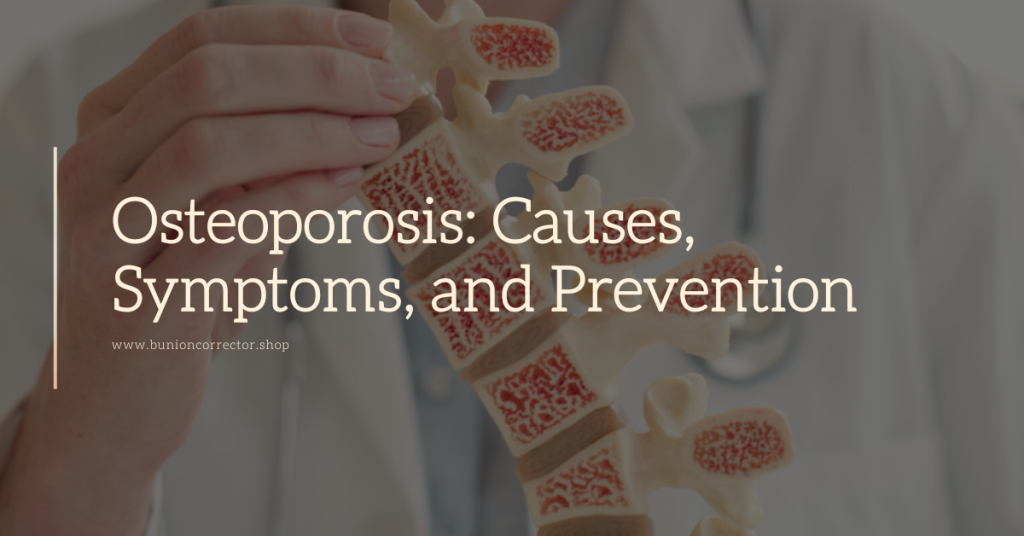Osteoporosis is a condition that affects millions of people worldwide, but many still don’t fully understand what it is or how it impacts their daily lives. Simply put, osteoporosis weakens bones, making them fragile and more likely to break. It’s often called a “silent disease” because it doesn’t have obvious symptoms until a bone breaks. This blog will explore osteoporosis, who is at risk, how it can be prevented, and ways to manage it if you’re diagnosed.

What is Osteoporosis?
Osteoporosis is a bone disease that occurs when the body loses too much bone, makes too little bone, or both. As a result, bones become weak and are more prone to fractures, especially in the hips, spine, and wrists.
Our bones are living tissue, constantly breaking down and being rebuilt. This process is called bone remodelling. However, the balance between bone breakdown and rebuilding can shift as we age. When bones break down faster than they rebuild, they become thinner and weaker.
How Does Osteoporosis Develop?
Osteoporosis develops when bone density decreases. Bone density is a measurement of how strong your bones are. When you are young, your body produces new bone faster than it breaks down old bone, increasing bone mass. But after age 30, bone mass peaks, and the body begins to lose bone mass more quickly than it can replace it.
This loss of bone mass is what leads to osteoporosis. The bones become porous, like a sponge, and fragile, making them much more likely to break from a fall or, in severe cases, from something as simple as sneezing or bumping into furniture.
Who is at Risk of Osteoporosis?
This can affect anyone, but certain factors increase the risk:
Age
One of the most significant risk factors for osteoporosis is age. As mentioned, bone mass peaks in early adulthood and begins to decline, especially after age 50. The older you are, the greater your risk.
Gender
Women are at a much higher risk than men. This is because women generally have smaller, thinner bones and experience a rapid drop in estrogen levels during menopause, which accelerates bone loss.
Family History
If osteoporosis runs in your family, you are more likely to develop it. Genetics significantly determines bone mass and how much bone density you may lose as you age.
Lifestyle Factors
Confident lifestyle choices can increase your risk of developing this. These include:
- Lack of physical activity: Regular exercise, especially weight-bearing activities like walking or lifting weights, helps maintain bone density.
- Poor diet: Not getting enough calcium and vitamin D can weaken bones.
- Smoking and excessive alcohol consumption: Both can interfere with the body’s ability to absorb calcium and rebuild bone.
Medical Conditions and Medications
Certain medical conditions, such as rheumatoid arthritis, thyroid problems, or gastrointestinal diseases, can contribute to bone loss. Some medications, especially long-term use of steroids, can also increase your risk.
Signs and Symptoms of Osteoporosis
One of the most challenging aspects of osteoporosis is that it typically doesn’t show any symptoms until a fracture occurs. This is why it is often referred to as a silent disease. However, there are some signs to look out for:
- Back pain can occur if the spine’s bones are weakened, causing them to collapse.
- Loss of height over time: Osteoporosis can cause the spine to compress, reducing height.
- Stooped posture: This is often due to fractures in the spine.
- Fractures: A broken bone from a minor fall or injury could be the first sign of osteoporosis.
If you experience any of these symptoms, you must talk to your doctor, especially if you are at a higher risk of osteoporosis.
How is Osteoporosis Diagnosed?
This is typically diagnosed through a bone density test called a DEXA scan (dual-energy x-ray absorptiometry). This test measures the density of bones, usually in the hip and spine, and can detect osteoporosis before a fracture occurs.
The results of a DEXA scan are reported as a T-score:
- Normal: A T-score of -1.0 or above
- Osteopenia: A T-score between -1.0 and -2.5, indicating low bone density
- Osteoporosis: A T-score of -2.5 or lower
If your T-score indicates osteoporosis, your doctor may recommend treatment to help strengthen your bones and prevent fractures.

Preventing Osteoporosis
While some risk factors for this, like age and family history, can’t be changed, you can make several lifestyle changes to help prevent bone loss.
- Eat a Bone-Healthy Diet
Your bones need calcium and vitamin D to stay strong. You can get calcium from dairy products like milk, cheese, and yogurt, as well as from leafy green vegetables and fortified foods. Vitamin D helps your body absorb calcium, which you can get from sunlight, supplements, or foods like fatty fish and fortified cereals.
- Exercise Regularly
Weight-bearing exercises like walking, dancing, and strength training can help maintain bone density and reduce the risk of osteoporosis. Aim for at least 30 minutes of exercise most days of the week.
- Avoid Smoking and Excessive Alcohol
Smoking and drinking too much alcohol can weaken your bones. If you smoke, quitting can improve your bone health. Limiting alcohol to moderate levels can also help protect your bones.
- Consider Medications
In some cases, especially if you’re at high risk for fractures, your doctor may prescribe medication to help prevent bone loss. These medications include bisphosphonates, hormone therapy, and other treatments that help slow down or stop bone breakdown.
Living with Osteoporosis
If you have been diagnosed with osteoporosis, it can feel overwhelming, but there are many steps you can take to manage the condition and protect your bones.
- Make Your Home Safe
Preventing falls is crucial if you have osteoporosis. Make sure your home is well-lit and free of tripping hazards. Install grab bars in the bathroom, and use non-slip mats in areas that might be slippery.
- Use Assistive Devices
If you are unsteady, using a cane or walker can help prevent falls and fractures.
- Follow Your Treatment Plan
Following your doctor’s medication, diet, and exercise recommendations is essential. Regular check-ups and bone density tests can help monitor the progression of the disease and make any necessary adjustments to your treatment plan.
- Stay Active and Engaged
While being careful is essential, staying active can improve your balance, strength, and overall well-being. Staying connected with friends and family and engaging in activities you enjoy can help improve your quality of life.
Conclusion
Osteoporosis is a severe condition, but it doesn’t have to control your life. By understanding the risk factors, getting regular bone density tests, and making lifestyle changes, you can take steps to protect your bones and prevent fractures. If you’re diagnosed with osteoporosis, there are many treatment options available to help you manage the disease and live a whole, active life.